
|
THE LIBERTARIAN ENTERPRISE Number 833, August 9, 2015 While the battle for equality before the law was one of the most important political revolutions in history, we were a nicer people when we were free to offend one another.
The Phenomenon of the Reptile Show: a Free Market Triumph
Attribute to L. Neil Smith's The Libertarian Enterprise It has been a very busy summer between trying to catch up on various hobby related projects after finally getting my pickup truck off the back burner and getting it in service again. And on top of that—a death in the family and picking up extra time at my real job. Slowly but surely I am starting to catch up. Have been trying to write this article for nearly a month now—since I attended two reptile shows in my local area. And it has taken that long to finally get it organized. I have always wanted to tell the story about the marvels of the reptile hobby as a freedom issue to the Libertarian community and at the same time tell fellow reptile hobbyists a few things about Libertarianism and who their real friends and enemies are. But the more I think of it—some of them already know. Even I knew long before I came to understand Libertarianism. Most of us in the hobby which has spawned a veritable cottage industry have long championed the ideals of free market incentives for conservation of threatened and endangered species and regardless what part of the political spectrum we call home—we know that the contraband approach is bad and we strive to pursue excellence in the husbandry and breeding of our animals—either to conserve them—or in some cases create living works of art by creating new life forms. A major part of the problem in trying to tell our story is that it is too much for just a single article. So maybe it should start with an introduction and let the pictures I took tell the story. And they really do! The first one in New Stanton in late June turned out pretty good. A few venders even had turtles but thankfully nothing I had to have because I had no money. I was scraping together spare change just short of going through the couch cushions to come up with the $5 entry fee! 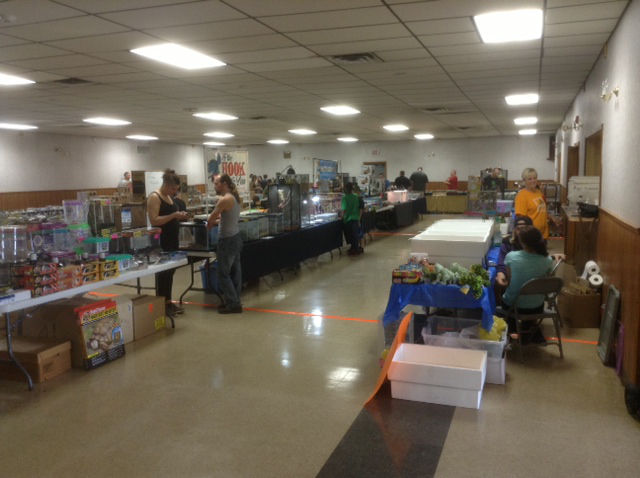 > >But it was worth it for just the excitement of doing something I had not done in many years. And getting a feel for what is out there. Mostly snakes and lizards but there were a few small turts. This vendor had baby Red Ear Sliders and Florida Softshells. 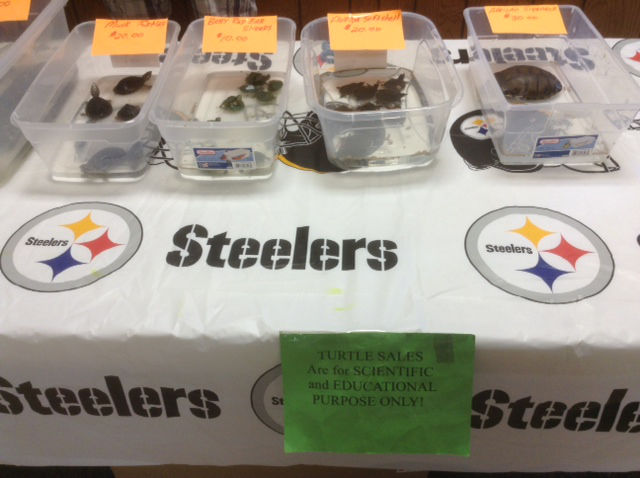 > >Love that disclaimer. It is sad that the 4 Inch Law is a disincentive for breeding turtles—which are less prolific and slower growing than snakes and could use all the help they can get to help perpetuate and conserve the rarer species. And the Bucket Heads are not much help in this matter either! 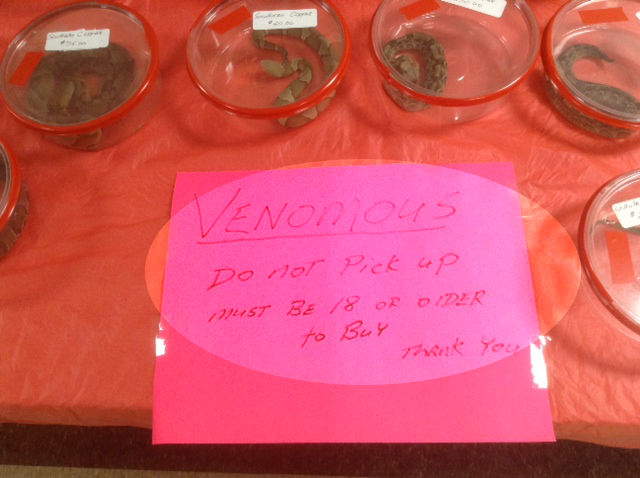 > >"Hot snakes"—at many shows they are banned along with native and "InDaynGered" herps and such deals are usually made out in the parking lot. Though I'm not into venomous—I admire the sponsors for not being squishes. I also admire those with the dedication and discipline to handle dangerous animals safely and responsibly.  > >There is a lot of variety in Ball Pythons and Corn Snakes like the ones being exhibited by this vendor. Just a few decades of selective breeding has produced probably more color and pattern morphs than exist in goldfish and may someday rival dogs and cats! 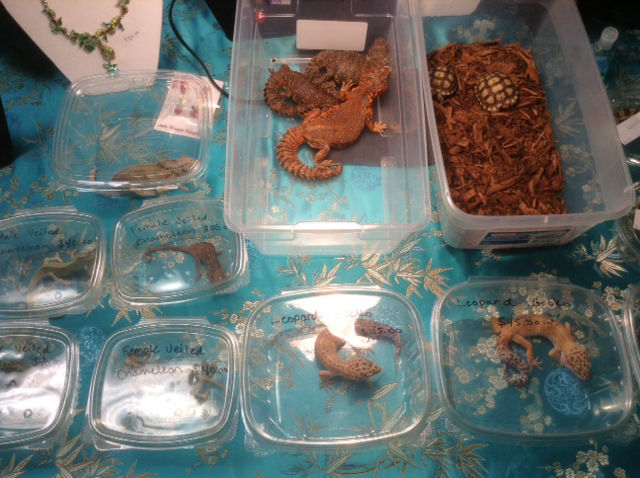 > >Leopard Geckos Another staple species with lots of color morphs that boggle the mind. And they are probably the easiest lizards to keep which makes them at least number 3 in the herptile hobby. This vendor also has Veiled Chameleons which require more specialized care and like Dart Frogs are more for specialized hobbyists. The big lizards upper right are Uromastix which are a little less difficult but are desert dwellers and need heat. There were also two baby Spur Thighed Tortoises the size of ping pong balls. Cute as a button but what they grow up into is a little less cute and may be hard to manage unless you live in a warmer climate and can keep them outside all year! 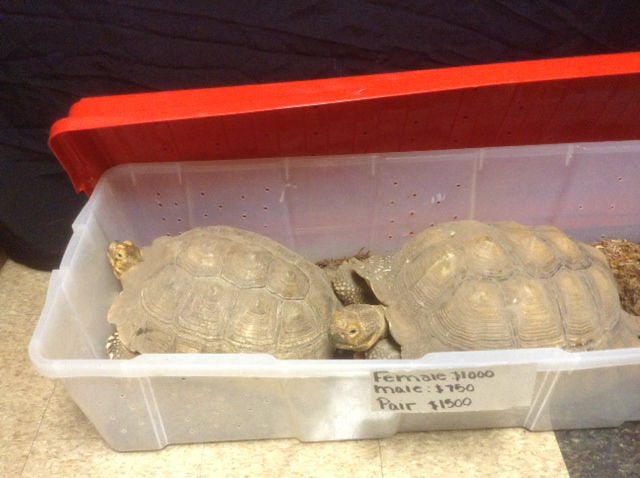 > >This pair was being offered for sale because the owner was getting old and bringing them inside for the winter was too! Reason I prefer box turtles over tortoises. But to each his own. 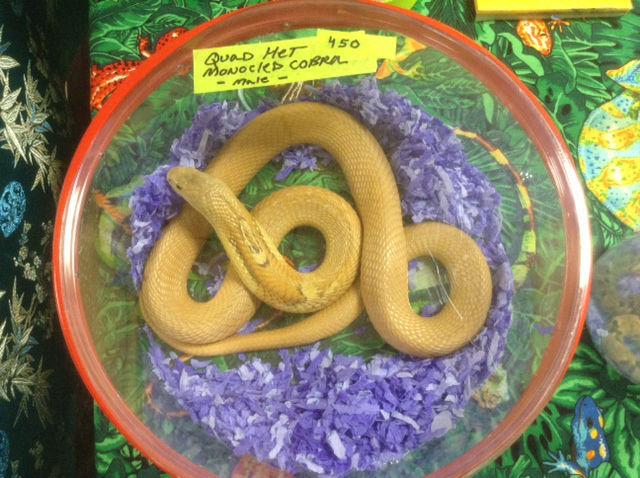 > >More Hot Snakes! 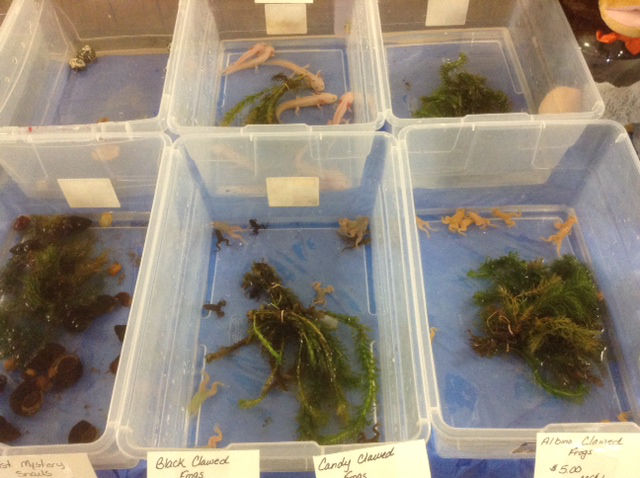 > >African Clawed Frogs. These used to be used as lab animals for doing pregnancy tests! 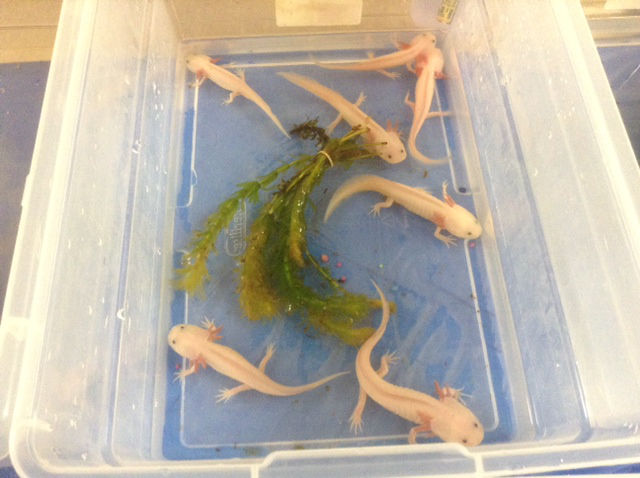 > >Axolotls. Another species used as a lab animal before it became one of the popular pet amphibians. Before that it was considered a delicacy by the Aztecs who harvested these creatures from the lake to which they were endemic. Now completely filled in and paved over by Mexico City. It survives for the most part as a domesticated animal. 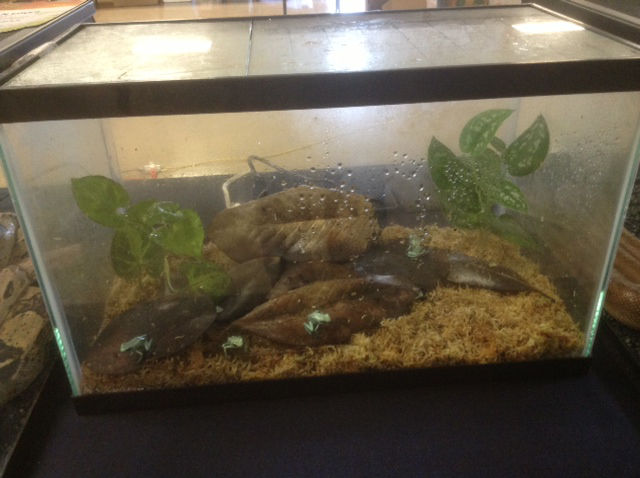 > >Poison Dart Frogs—Dendrobates sp in a naturalistic Vivarium setup. These frogs are highly toxic and some species are even dangerous to touch with your bare hands. In captivity they are reputed to loose their potency—perhaps because something is missing from their diet or the diet of the insects upon which they feed. Takes a dedicated hobbyist to maintain these small, delicate frogs and an abundant supply of very small bugs—pinhead crickets or roach nymphs, fruit flies, springtails, ants or termites. Feeding captive reptiles and amphibians has spawned yet another cottage industry.  > >Feeder rodents both live and frozen. 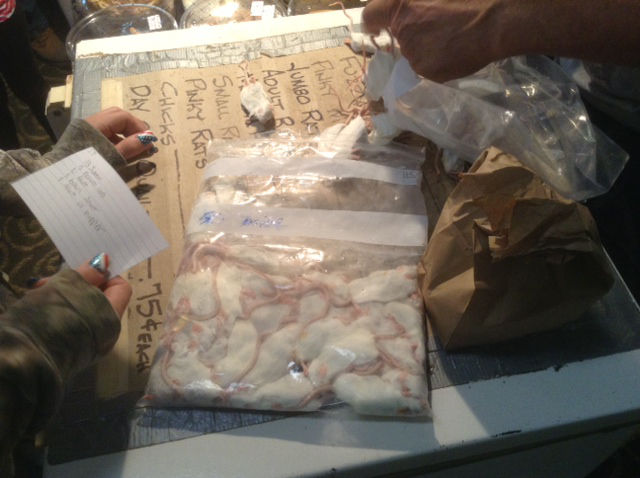 > >I have raised my own mice in the past when I had snakes and found that keeping a supply of frozen rodents on hand in a ziplock bag can be less smells and hassle than maintaining a live colony. But if you are up to the challenge that in itself can be an enterprising opportunity.  > >And there are the bugs.  > >Plus an impressive array of heating pads, basking lights and many other cage furnishing, specialized animal feed and other dry goods that is truly amazing. Some of the best enlightenment in the way of understanding how creativity and passion drive the free market can be had at a reptile show! 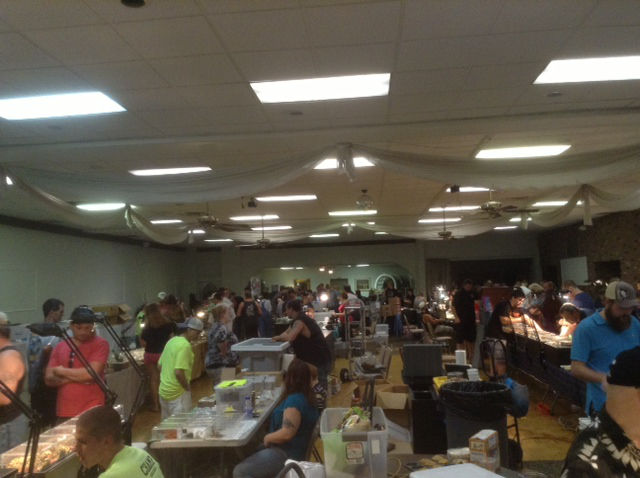 > >Went to another one the following Sunday which I almost decided not to bother with on the grounds that I could have gotten a lot of stuff done at home on what was an all around warm, dry and pleasant summer day. But I was glad in the end that I did. The show was an enjoyable experience and it was slightly better than the other one as I figured it would be closer to the city. And it was not hard to get to. Not far beyond the Monroeville exit in an old motel on the north shore of the Allegheny River. Like many reptile shows it was mostly snake city—but some lizards—Leopard Geckos, Bearded Dragons, monitors and one guy had Blue Tongue Skinks. A couple vendors from the last show who had red eared sliders and a few other turtles were there along with a lady selling Diamondback Terrapins. 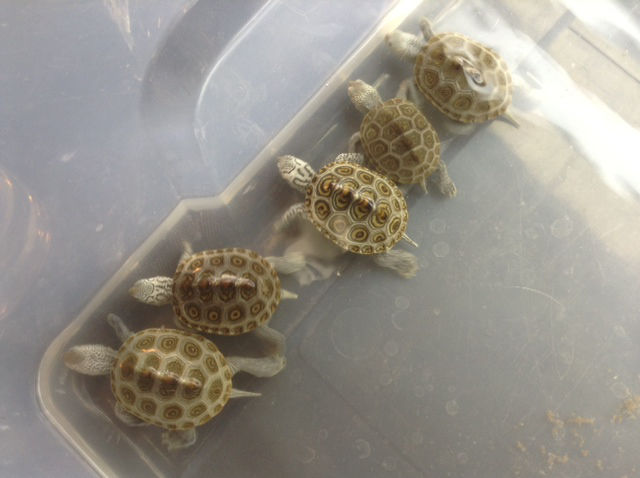 > >There was also a guy with dart frogs in impressive setups. And dry goods and feeders. I'm more and more leaning in favor of Dubia roaches over lobsters as the Dubia can't climb plastic or glass and don't need a Vaseline barrier.  > >There were also some interesting snakes. A huge male Sinaloan Milk Snake for $75 that was probably a retired breeder and some hybrids. One in particular—the Imperial Pueblan which was a cross between a Pueblan Milk and California King back crossed with a Pueblan. 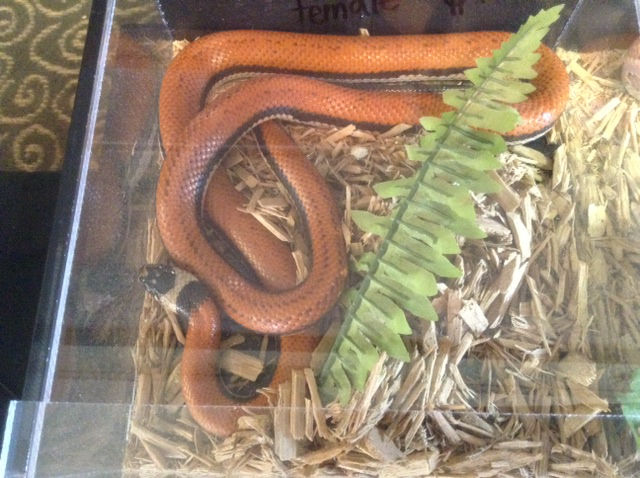 > >I also had an interesting conversation at that table concerning one of my old favorites I am thinking of getting back into; the Appalachicola Kingsnake . The Feds are thinking about listing them which would really suck much like the current case of the critically endangered Indian Spotted Pond Turtle: Geoclemmys Hamiltoni which has so much red tape red that breeders are state locked. Ironic considering there are probably far more Apalachicola Kings in captive bred populations than the wild and the same would be true for Geoclemmys too if the government control freaks would get out of the way. 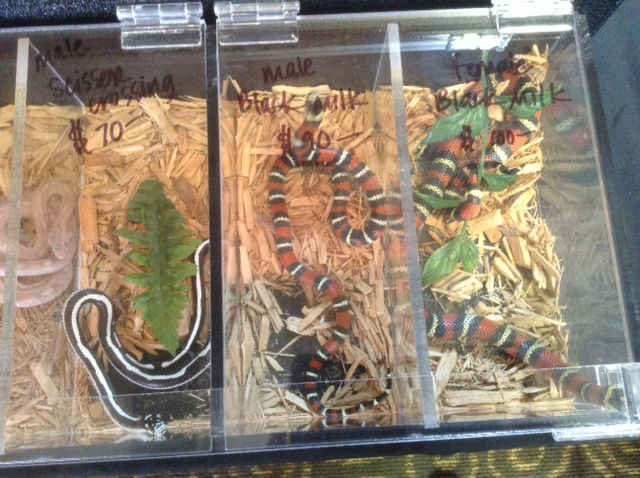 > >This particular vender also had a nice striped phase Cal King hatchling and some baby Black Milks which look pretty much like your generic tricolor Milk Snakes—but turn jet black as they mature. I remembered that from Merkel's "King Snakes & Milk Snakes which I bought from a pet shop way back when my friend Mike and I had gotten into the craze back in our Air Force days with a clandestine snake collection in the dorms at Andrews. Another story that someday will have to be told. Those were the days of searching the local pet shops and the backwoods of Tidewater Maryland and visiting the snake rooms of Chuck the Snake Man and Carl Bartlett and other local herp enthusiasts in search of something new and rare. At the Penn State Symposium in the summer of 91 I first learned that it was possible to create hybrids from some of the most unlikely colubrid snakes—such as the Jungle Corn which is a cross of the familiar Corn Snake with a California Kingsnake. From a speaker who had to be the classic environmental alarmist who made it sound like the beginning of the end with an apocalyptic scenario of the world being overrun with "mutt" breeds of snakes that could probably give the purveyors of the current Craypocalypse scare a run for their money. As it turns out—snakes of the family Colubridae are a very flexible bunch when it comes to genetics; capable of producing even intergeneric crosses much like many orchids. The Jungle Corns that were among the first are the classic example—Elaphe (sic Pantherophis) guttata X Lampopeltis getula californiae. To this day I can still recall how comical it was as the guy at Penn State recited the Latin binomials. And as time went on it got even crazier with crosses of Corns and Sinaloan Milks, Kings and the Pine/ Bull / Gopher Snake genus (Pituophis), Grey Banded and the various tricolored Mountain Kings and eventually the ultimate mutt that combined several of the above crosses to create what the breeder dubbed ; "Heinz 57"! After the show I did a little research online and apparently the controversy of hybrid snakes is alive and well. To some it is a quest to create a new breed with great appeal—living works of art. To others it is an evil equivalent to the creation of GMOs. In a way these hybrid snakes are GMO—being the creation of human beings rather than natural processes. Mainly because such crossings are rare in the wild where some of these animals even share the same habitat—like King and Corn Snakes which both are common in the coastal areas of the Mid-Atlantic and all across the Deep South. But usually when a Kingsnake comes across a Corn or Rat Snake in the wild it is more likely to consider it lunch rather than a love interest! Snake breeders are reputed to use a bait and switch tactic of putting a male King Snake with a female of his own species until he is sufficiently hot and bothered and then replacing it with a receptive female Corn Snake or other. Artificial insemination is probably used as well. But is it really a bad thing. Or even a danger to the integrity of species or the ecosystem? Most hybrid snakes—and there are hybrid turtles now too!—don't thrill me. The Jungle Corns and the Sinaloan Corn crosses just don't look right to me. But I have to admit that the Pueblan X Cal King X Pueblan which I believe is officially called an "Imperial Pueblan" actually looks kind of cool. Like something that might actually be produced by natural evolution—or as a result of line breeding within the species itself. Some breeders are producing patternless milk snakes by selectively breeding aberrant snakes which have areas where the banding is altered or absent until they get a population in which the pattern is completely obliterated. In the case of the Imperial Pueblan—it looks as if hybridization is the short cut to achieve the same by using the genes of the striped Cal King to eliminate the tricolor pattern. In the example I photographed at the show; you can see the trace of the striped Cal King influence in a series of dotted lines running dorsally on the back of the snake. That subtile effect is intriguing in itself making this snake a living work of art that would make our beloved heretic Freeman Dyson proud! 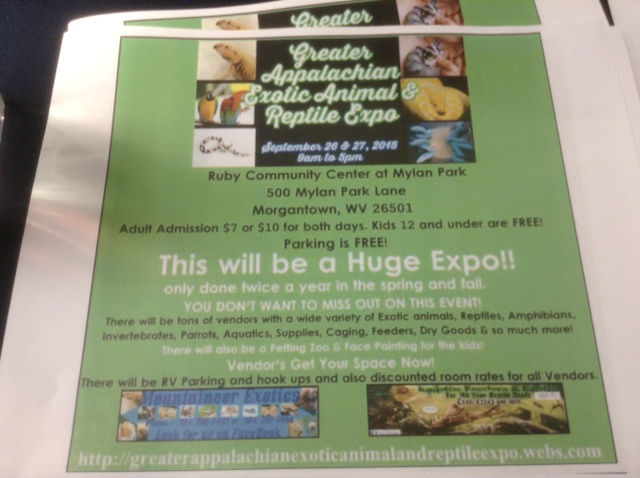 > >And perhaps the best is yet to come! And on the home front:  > >In my own pursuit of happiness and excellence I finally finished two Cadillac turtle pens to provide my Gulf Coast and Chinese Box Turtles very spacious enclosures that are both naturalistic and secure against predators. 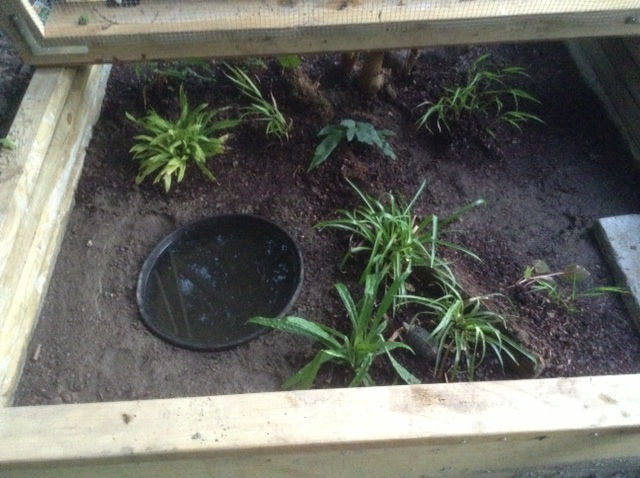 > >In a way—despite the violation of personal liberty and peace of mind—the Bucket Heads may have done me a favor. In my efforts to get away from them I am still striving to create new and better things. Works of art both Freeman Dyson and Philipe De Vosjoli would find good!
Just click the red box (it's a button!) to pay the author
This site may receive compensation if a product is purchased
|
